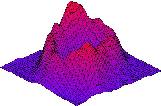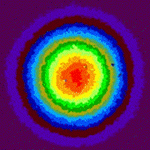|
Generalized N-body Problems
| |
In my thesis, I unified for the first time a large class
of problems which I call generalized N-body problems. These
problems have the essential structure of the Coulombic N-body
problem of computational physics, consisting of decomposable operators
(like summation or maximization) on evaluations of certain kernel
functions on n-tuples of points in a D-dimensional metric space.
All of the problems listed in this column, and many other important problems
not listed (I could list at least 50), are examples of such problems.
The first (and very brief) paper discussing much of the big picture
was (Gray and Moore,
'N-Body' Problems in Statistical Learning [pdf]
[ps],
presented orally at NIPS 2000), but is now outdated.
The full story is much longer and is
still unfolding at a fast pace, so it will eventually appear probably in
monograph (focused book) form in the near future. Individual results
will also appear in journal form very soon.
|
 |

|
 |
What makes the problem class interesting is that is possible to devise
a unified solution approach for this class, as shown in my thesis. It
is based on the introduced principle of higher-order
divide-and-conquer, or divide-and-conquer over multiple sets (a
principle which is actually more general than what is needed here) --
in this case over multiple space-partitioning data structures. I
utilize the best data structures for
proximity search, which are data-adaptive, unlike the typical
structures of computational physics. My way of using such structures
yields strict error bounds in non-exact cases. I used this general
strategy to develop new algorithms, which I call dual-tree or
more generally multi-tree methods. Each method, listed in this
column, demonstrates how the same basic algorithmic methodology
specializes to each problem. In addition to passing an empirical test
versus the best existing methods, most of the algorithms here have
been heavily used in significant applications.
|
 |
 |
 |
 |
|
Kernel Density Estimation
| |
∀ xq ∑r
Kh(|| xq - xr ||)
Kernel density estimation is the canonical statistical method for the
fundamental problem of estimating general probability densities
(i.e. without distribution assumptions), but its intractability
has limited its use since its introduction in the 1950's. Our method
for this problem can be extended to solve local polynomial
regression problems.
|
|
 |
|
Our dual-tree algorithm, utilizing a simple finite-difference scheme,
turns out to be faster than all previous proposals for the same
accuracy, including the FFT and the fast gauss transform, dramatically
so beyond 2 or 3 dimensions. It works for all common kernel
functions, can perform multiple bandwidths simultaneously for faster
cross-validation, provides hard error bounds, and requires no
parameter tweaking. (Gray and Moore, Nonparametric Density
Estimation: Toward Computational Tractability, SIAM Data Mining
2003 [winner of Best Algorithms Paper Prize]. Gray and Moore,
Rapid Evaluation of Multiple Density Models [pdf],
[ps] AI & Statistics 2003. Final journal version
coming very soon.)
|
|
 |
|
n-point Correlation Functions
| |
∑q ∑r ∑s
I∇(xq, xr, xs)
The n-point correlation functions form the foundation of
spatial statistics, and constitute the principal means by which
cosmologists have validated the best existing cosmological models with
respect to observations since the 1960's. Their naive computational
cost is O(Nn). The n-point
correlation functions are also used heavily in statistical physics and
other areas of physics. The fractal dimension is isomorphic
to the 2-point correlation.
|
|

|
|
Our n-tree algorithm is the first algorithm to dramatically reduce the
cost, by up to seven orders of magnitude in practice, while returning
the exact answer. This has made higher-order correlations on large
modern datasets, which are necessary for cosmological studies, possible for the first
time. (First described in the NIPS 2000 paper. Moore et al., Fast Algorithms
and Efficient Statistics: n-point Correlation Functions [pdf] [ps], Mining
the Sky 2000. Fast Computation of the Pair Correlation and
n-point Correlation Functions, Conf. Computational Physics
2004.) We have also developed a Monte
Carlo algorithm which is faster for large radii. Final journal version
coming very soon.
|
|
 |
∀ xq argminr
|| xq - xr ||
The all-nearest-neighbors problem asks, for each of a set of query
points, what is its nearest neighbor among a set of reference points.
In the more general bichromatic version, the query set and reference
set may be different. Aside from being a classical challenge problem
of computational geometry, this is often the real problem of interest
in practice, not the single-query problem.
|
|

|
|
Our simple dual-recursive depth-first-search algorithm turns out to be
faster than the best previous algorithms in practice, including
Vaidya's algorithm and the well-separated pair decomposition. It is
exact, solves the more general bichromatic problem, works for general
k, and as with all of our algorithms on this page, it works
with virtually any space-partitioning tree. (First described in the
NIPS 2000 paper. Full experimental results and detailed description
will appear in the paper associated with the Proximity Project hopefully sometime in
2005.)
|
|
 |
|
Nonparametric Bayes Classification
| |
∀ xq max{
P(C1)ph(xq|C1),
P(C2)ph(xq|C2)}
|
Nonparametric density estimation used within the Bayes decision
framework provides simple nonlinear Bayes-optimal classification without
parametric assumptions, and, less known, performance comparable to the
state of the art in practice. Our method for this problem can also be
used for support vector machine prediction -- however, in that
context we only achieved speedups over the naive method of about 2-3. I
therefore consider this methodology to be a failure for that problem.
|
|

|
|
Our algorithm for this problem utilizes three trees for a 2-class
problem, and two Fibonnaci-heap priority queues. It is exact
-- this is the reward for not simply performing one approximate
kernel summation for each class.
It allows the nonparametric Bayes classifier to
scale to massive training and test sets, unlike methods like SVM's,
and has been used with high accuracy in a large-scale quasar detection problem and a drug discovery problem. (Though these
applications of the algorithm have been published, the algorithm
itself has not, and will be submitted in 2005.)
|
|
 |
|
Gaussian Process Regression
| |
Φ-1y, Φu
|
Gaussian process regression is a Bayesian regression method, related
to the method of kriging, whose principal required computation is the
inversion of an N×N matrix. Gaussian process
regression is an example of a more general situation within
statistics/machine learning of a kernel matrix-vector multiplication.
|
|

|
|
In this case it occurs inside Skilling's matrix inversion method. An
extension of our algorithm for kernel density estimation can be used
for this. A preliminary demonstration of this for a 1-million-point
dataset is in (Gray, Fast Kernel Matrix-Vector Multiplication with
Application to Gaussian Process Regression [pdf], [ps] CMU tech report 2004). I consider this work
incomplete though, because the validation was only done on one dataset
and I would like to see the method used by a GP expert in a real application.
|
|




